Gail Ingis's Blog, page 12
October 4, 2017
Barcelona beauty to Disney Magic

Barcelona welcome
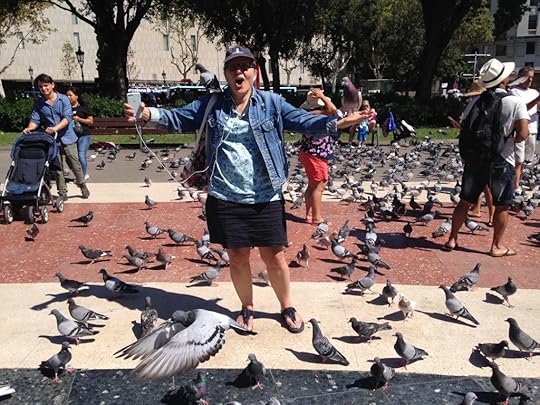
The Birds . . .
Hey, if you love to travel then have some fun while I take you on the start of our recent two-week trip of amazing sightseeing and cruising.
Our first stop was Barcelona, Spain. What a glorious city. It was good to be back. We spent three days there. Everywhere we went, there was beauty and delicious food. Especially the tapas! If you go to Barcelona, you have to eat tapas-style. It’s a fun way to eat with plenty to choose from. We all enjoyed the selection. My hubby, Tom, our son Paul, daughter-in-law, Joanne, and I did a pretty good job of trying many different tapas dishes.
 Tapas are on every counter in every café and restaurant. And don’t ask how we got seated, because you can’t get served unless you are sitting down or taking it away. Every tapas place we visited was packed. We always wanted to sit at the counter, those were favored spots because then you could pick from the tapas close up. But it was tough to get those seats. The four of us ate our way through the most popular and delicious tapas. By the end of the three days, we were ‘tapased’ out.
Tapas are on every counter in every café and restaurant. And don’t ask how we got seated, because you can’t get served unless you are sitting down or taking it away. Every tapas place we visited was packed. We always wanted to sit at the counter, those were favored spots because then you could pick from the tapas close up. But it was tough to get those seats. The four of us ate our way through the most popular and delicious tapas. By the end of the three days, we were ‘tapased’ out.
Las Ramblas, the famous street that appealed to tourists and locals is the most popular, busiest street in Barcelona. A tree-lined pedestrian mall, it stretched for less than a mile connecting Plaça de Catalunya in the centre with the Christopher Columbus Monument at Port Vell. Wikipedia. I have to tell you about the bathroom wherever we went. Every one of them were spanking clean and sparkling.

Thoughtful memorial

Monument
Tom and I remembered the street performers from our 2010 trip. We wished they were there so we could all see them do their thing, maybe next trip. Flowers dedicated to those who lost their lives a few weeks before we arrived, were spread over the base of the Christopher Columbus Monument, at the entrance of the wide avenue. A beautiful and fit memorial. Christopher Columbus Monument, at the entrance of the wide avenue. A beautiful and fitting memorial.
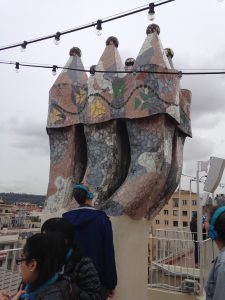
Casa Mila roof
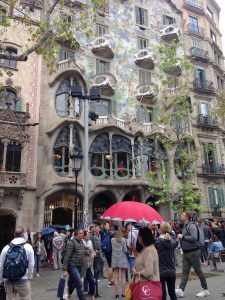
Casa Mila
We were surrounded by the designs of Antonio Gaudi,19th century architect who thought out-of-the-box. Nowhere else in the world will you see his designs as in Barcelona. His church, the most famous anywhere, the Sagrada Familia, which began construction in 1882/1883, is still under construction. Really!
If you like dragons, you’ll love the Gaudi apartments and rooftops. On Las Ramblas all streetlights and benches are Gaudi designed. His Art Nouveau creations are all over the city.

Barcelona’s main means of travel
Our accommodations were divine at the AC Marriott on the north side of the city. They had their own restaurant with great food and tapas, of course. Designs were contemporary and sleek in steel, glass and leather. Transportation was easy by taxi, metro or bus and walking. So many walk or motorbike and sometimes you see manual biking.

Getting around Barcelona is easy on the metro. Clean and sparkling!
I have to tell you about the bathrooms and the subway. Everywhere we went, every one of them were sparkling clean. We can learn a thing or two from these Europeans, don’t you think?

Joanne finding polished glass in the sand, fun to look.
 We loved our little jaunt to the beach. Joanne waded in the Mediterranean as we cheered her on, we picked polished glass from the sand, enjoyed the sand castles with fireplaces, and danced in the plaza with all the dancing couples. We didn’t want the dream to end.
We loved our little jaunt to the beach. Joanne waded in the Mediterranean as we cheered her on, we picked polished glass from the sand, enjoyed the sand castles with fireplaces, and danced in the plaza with all the dancing couples. We didn’t want the dream to end.

Sand fireplaces
 I forgot to mention the VIP greeting that we received when we arrived in Barcelona. Thank you to son Paul’s client.took us through the airport and out to taxi service. Imagine VIP status, even temporarily?
I forgot to mention the VIP greeting that we received when we arrived in Barcelona. Thank you to son Paul’s client.took us through the airport and out to taxi service. Imagine VIP status, even temporarily?
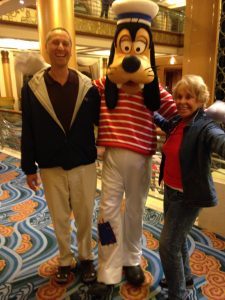
Pluto greeting on Disney Magic
After our three-day whirlwind stay in Barcelona we boarded the Disney Cruise Ship for a ten-day cruise across the Atlantic. I’ll tell you more about that amazing “boat trip” next week.

Indigo Sky for the reader who enjoys historical romance! @AmazonKindle http://amzn.to/2nWqbcq Indigo Sky available on Amazon buy link: http://amzn.to/2j0LXLE
Author page: http://amzn.to/1K4GVQA
September 28, 2017
You want to be a writer. Now what? by Gail Ingis
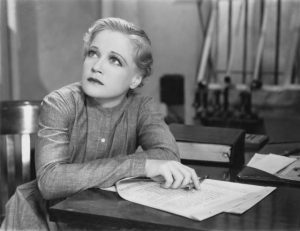
How do you do this writing thing?
I kind of fell into writing fiction by accident. You see, I’m an artist (a painter) and for many, many years I was an interior designer and taught design and architecture as well. I was always an avid reader. But a writer? No way! Until I was inspired by painter Albert Bierstadt and I wanted to tell a story inspired by his life.
I know, I said to myself, I’ll write a book. After all, I had written a chapter for a history book and been wooed by a publisher. I wrote up school catalogs, wrote course curriculum, wrote up interior design and architectural history lectures, proposals for jobs, poetry and love letters. Surely writing a book would be a piece of cake. Sure, right.
I sat down, pen in hand, put pen down—booted up my trusty Mac, surely that would inspire me . . . but that didn’t help. This is not going to work. What do I write first, the end? What words do I use? How do I find my characters? Where does all this come from? It shouldn’t be any different than giving a lecture. OK, I though smugly, I’ll approach it like a lecture. I could talk for hours about interior design, lighting, space planning, history, architectural anything. Still nothing. I remember the emptiness, the confusion, the lack of words. I didn’t think I had this gift to tell a story, never mind, writing one.

Tommy the train to NYC
Then I met Brenda on a train ride into New York. We were both on our way to a Michael Hauge workshop. Hauge is a screenwriter who teaches writing courses. Brenda and I became friends after that class. I learned a great deal from Hauge but also from Brenda who helped me get my thoughts together and helped me formulate my story. But Brenda was busy with her growing family and her full time job as an attorney, so I had to continue my search for help. During a CTRWA Fiction Fest, in 2009, “Inspiration for Writers” offered free editing service for the auction. I bought enough tickets to win it. Yay, That’s how I found Charl, who is an editor for them.
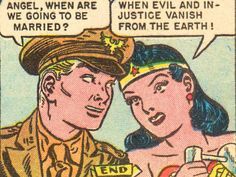 Creativity is a right brain activity. Have you explored your creativity? Do you remember being creative as a kid? I sure do. Comic books were the rage when I was growing up. (They still are). I would sit at my desk and draw what I saw in the comic books. Wonder Woman was my hero. As I got older, I drew all kinds of things. I played the piano, I took dance lessons, voice lessons, sang in school shows, sang in school choir, took my mother’s dresses apart and remade them. Took my radio apart and my clock apart and put them back together, well, with Daddy’s happy help, it was my curiosity that pushed me to explore. The list goes on, and I wrote little poems and notes to friends and family. I realized that I had always had that passion for storytelling inside me all along. I had just been using different mediums to tell my stories.
Creativity is a right brain activity. Have you explored your creativity? Do you remember being creative as a kid? I sure do. Comic books were the rage when I was growing up. (They still are). I would sit at my desk and draw what I saw in the comic books. Wonder Woman was my hero. As I got older, I drew all kinds of things. I played the piano, I took dance lessons, voice lessons, sang in school shows, sang in school choir, took my mother’s dresses apart and remade them. Took my radio apart and my clock apart and put them back together, well, with Daddy’s happy help, it was my curiosity that pushed me to explore. The list goes on, and I wrote little poems and notes to friends and family. I realized that I had always had that passion for storytelling inside me all along. I had just been using different mediums to tell my stories.
I didn’t just want to think of a story, I wanted to write that book, and in spite of myself, i did. I took enough workshops and writing courses to earn a PhD in “workshop-taking”. And with the help of Charl I was able to complete my very first book, Indigo Sky. I am a member of the Connecticut Chapter of the Romance Writers of America, where writers gather and help each other. Being a member of the CTRWA, I was exposed to many different publishing companies, big and small and with Jamie S’s help where to submit. I landed a publishing contract with Soul Mate Publishing. With the help of my editor, Tammie, at Soul Mate, who worked very hard with me, I completed the re-writes and the book was published in 2015.

Amazon link: http://amzn.to/2j0LXLE
Author page: http://amzn.to/1K4GVQA
My book can be found in three formats, paperback, eBook and Audiobook. I even have a book trailer! Two things have changed in my life since that fateful day I decided to start writing: 1. I became a published author. 2. I have made so many wonderful friends along the way. I wish you all the same creative journey.
You want to be a writer. Now what? by Gail Inglis

How do you do this writing thing?
I kind of fell into writing fiction by accident. You see, I’m an artist (a painter) and for many, many years I was an interior designer and taught design and architecture as well. I was always an avid reader. But a writer? No way! Until I was inspired by painter Albert Bierstadt and I wanted to tell a story inspired by his life.
I know, I said to myself, I’ll write a book. After all, I had written a chapter for a history book and been wooed by a publisher. I wrote up school catalogs, wrote course curriculum, wrote up interior design and architectural history lectures, proposals for jobs, poetry and love letters. Surely writing a book would be a piece of cake. Sure, right.
I sat down, pen in hand, put pen down—booted up my trusty Mac, surely that would inspire me . . . but that didn’t help. This is not going to work. What do I write first, the end? What words do I use? How do I find my characters? Where does all this come from? It shouldn’t be any different than giving a lecture. OK, I though smugly, I’ll approach it like a lecture. I could talk for hours about interior design, lighting, space planning, history, architectural anything. Still nothing. I remember the emptiness, the confusion, the lack of words. I didn’t think I had this gift to tell a story, never mind, writing one.

Tommy the train to NYC
Then I met Brenda on a train ride into New York. We were both on our way to a Michael Hauge workshop. Hauge is a screenwriter who teaches writing courses. Brenda and I became friends after that class. I learned a great deal from Hauge but also from Brenda who helped me get my thoughts together and helped me formulate my story.
 Creativity is a right brain activity. Have you explored your creativity? Do you remember being creative as a kid? I sure do. Comic books were the rage when I was growing up. (They still are). I would sit at my desk and draw what I saw in the comic books. Wonder Woman was my hero. As I got older, I drew all kinds of things. I played the piano, I took dance lessons, voice lessons, sang in school shows, sang in school choir, took my mother’s dresses apart and remade them. Took my radio apart and my clock apart and put them back together, well, with Daddy’s happy help, it was my curiosity that pushed me to explore. The list goes on, and I wrote little poems and notes to friends and family. I realized that I had always had that passion for storytelling inside me all along. I had just been using different mediums to tell my stories.
Creativity is a right brain activity. Have you explored your creativity? Do you remember being creative as a kid? I sure do. Comic books were the rage when I was growing up. (They still are). I would sit at my desk and draw what I saw in the comic books. Wonder Woman was my hero. As I got older, I drew all kinds of things. I played the piano, I took dance lessons, voice lessons, sang in school shows, sang in school choir, took my mother’s dresses apart and remade them. Took my radio apart and my clock apart and put them back together, well, with Daddy’s happy help, it was my curiosity that pushed me to explore. The list goes on, and I wrote little poems and notes to friends and family. I realized that I had always had that passion for storytelling inside me all along. I had just been using different mediums to tell my stories.
I didn’t just want to think of a story, I wanted to write that book, and by golly i did. I took enough workshops and writing courses to earn a PhD in “workshop-taking”. And with the help of my writer friend Brenda, I was able to complete my very first book, Indigo Sky. I am a member of the Connecticut Chapter of the Romance Writers of America, where writers gather and help each other. Being a member of the CRWA, I was exposed to many different publishing companies, big and small. I landed a publishing contract with Soul Mate Publishing. With the help of my editor, who worked very hard with me, I completed the re-writes and the book was published in 2015.

Amazon link: http://amzn.to/2j0LXLE
Author page: http://amzn.to/1K4GVQA
My book can be found in three formats, paperback, eBook and Audiobook. I even have a book trailer! Two things have changed in my life since that fateful day I decided to start writing: 1. I became a published author. 2. I have made so many wonderful friends along the way. I wish you all the same creative journey.
September 21, 2017
What does the Gilded Age have to do with Katherine Hepburn and Spencer Tracy?
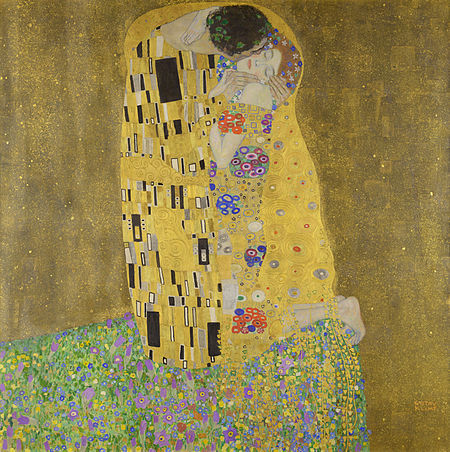
The Kiss (Lovers), oil and gold leaf on canvas, 1907–1908 Gustav Klimt (popular for its gilt)
The Gilded Age, circa 1870-1900, was a period of rapid economic and social growth characterized by the emergence of a wealthy middle class, excess and embellishment in architecture, art and fashion, fueled by mechanization, transportation, major inventions and the growth of cities. Under the surface however lay significant social tensions- corruption in politics, collusion in business and poverty among unskilled industrial workers, child labor and discrimination.The term “Gilded Age” comes from the satirical novel co-authored by Mark Twain and Charles Dudley Warner and published in 1873 (the process of gilding, applied a thin veneer of gold to a baser material such as pewter or tin to make the artifact appear more valuable, had recently been introduced). Twain likened it to an era of serious social problems masked by thin gold gilding.
 This era is also the time period of my upcoming novel THE UNFORGETTABLE MISS BALDWIN, Book 1 in the Baldwin Family Series. The series follows the lives and loves of the Baldwin siblings Adam, Allie, Mia, Emma and Ava. They are the children of a wealthy newspaper baron Joseph Baldwin and his charity-minded wife Clara who runs a children’s hospital in Manhattan. The series is pure romantic comedy in the vein of Katherine Hepburn and Spencer Tracy. I love classic Hollywood comedies and in a way, they were part of another “gilded age” or rather, a “golden era” of film if you will. And I wanted to infuse that spirit into my books. Along with my love of design and architecture.
This era is also the time period of my upcoming novel THE UNFORGETTABLE MISS BALDWIN, Book 1 in the Baldwin Family Series. The series follows the lives and loves of the Baldwin siblings Adam, Allie, Mia, Emma and Ava. They are the children of a wealthy newspaper baron Joseph Baldwin and his charity-minded wife Clara who runs a children’s hospital in Manhattan. The series is pure romantic comedy in the vein of Katherine Hepburn and Spencer Tracy. I love classic Hollywood comedies and in a way, they were part of another “gilded age” or rather, a “golden era” of film if you will. And I wanted to infuse that spirit into my books. Along with my love of design and architecture.
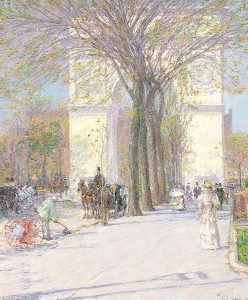
Washington Square, NY Childe Hassam, 1895
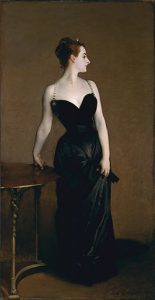
Madame X 1894 John Singer Sargent
For the purposes of this blog, I chose to point out the visual arts of the era when American painters emerged: Mary Cassatt, Winslow Homer, John Singer Sergeant, Childe Hassam and others. Art of the romanticized West by Albert Bierstadt, Charles Remington et al. Are we in a new Gilded Age? Which artists, in any creative field, will become associated with this era? 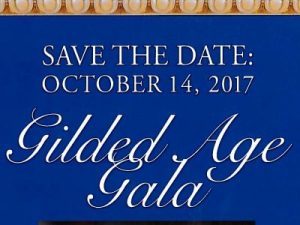
And I am so excited to be part of the organizing committee for a truly worthy cause. in Norwalk, Connecticut will be having its annual fundraising gala on October 14, 2017. And this year’s theme is – you guessed it – the Gilded Age. For more information you can contact them directly. General Inquiries and Visitor Information T. (203) 838-9799 Email info@lockwoodmathewsmansion.com
 Gail Ingis is an author and artist based in Connecticut. This blog is all about her passions: history, architecture, and interior design and fiction. Her current historical romance is INDIGO SKY. Gail’s upcoming release is the first book in a new series: THE UNFORGETTABLE MISS BALDWIN.
Gail Ingis is an author and artist based in Connecticut. This blog is all about her passions: history, architecture, and interior design and fiction. Her current historical romance is INDIGO SKY. Gail’s upcoming release is the first book in a new series: THE UNFORGETTABLE MISS BALDWIN.

What does the Gilded Age have to do with Catherine Hepburn and Spencer Tracy?

The Kiss (Lovers), oil and gold leaf on canvas, 1907–1908 Gustav Klimt (popular for its gilt)
The Gilded Age, circa 1870-1900, was a period of rapid economic and social growth characterized by the emergence of a wealthy middle class, excess and embellishment in architecture, art and fashion, fueled by mechanization, transportation, major inventions and the growth of cities. Under the surface however lay significant social tensions- corruption in politics, collusion in business and poverty among unskilled industrial workers, child labor and discrimination.The term “Gilded Age” comes from the satirical novel co-authored by Mark Twain and Charles Dudley Warner and published in 1873 (the process of gilding, applied a thin veneer of gold to a baser material such as pewter or tin to make the artifact appear more valuable, had recently been introduced). Twain likened it to an era of serious social problems masked by thin gold gilding.
 This era is also the time period of my upcoming novel THE UNFORGETTABLE MISS BALDWIN, Book 1 in the Baldwin Family Series. The series follows the lives and loves of the Baldwin siblings Adam, Allie, Mia, Emma and Ava. They are the children of a wealthy newspaper baron Joseph Baldwin and his charity-minded wife Clara who runs a children’s hospital in Manhattan. The series is pure romantic comedy in the vein of Catherine Hepburn and Spencer Tracy. I love classic Hollywood comedies and I wanted to infuse that spirit into my books. Along with my love of design and architecture.
This era is also the time period of my upcoming novel THE UNFORGETTABLE MISS BALDWIN, Book 1 in the Baldwin Family Series. The series follows the lives and loves of the Baldwin siblings Adam, Allie, Mia, Emma and Ava. They are the children of a wealthy newspaper baron Joseph Baldwin and his charity-minded wife Clara who runs a children’s hospital in Manhattan. The series is pure romantic comedy in the vein of Catherine Hepburn and Spencer Tracy. I love classic Hollywood comedies and I wanted to infuse that spirit into my books. Along with my love of design and architecture.

Washington Square, NY Childe Hassam, 1895

Madame X 1894 John Singer Sargent
For the purposes of this blog, I chose to point out the visual arts of the era when American painters emerged: Mary Cassatt, Winslow Homer, John Singer Sergeant, Childe Hassam and others. Art of the romanticized West by Albert Bierstadt, Charles Remington et al. Are we in a new Gilded Age? Which artists, in any creative field, will become associated with this era? 
And I am so excited to be part of the organizing committee for a truly worthy cause. in Norwalk, Connecticut will be having its annual fundraising gala on October 14, 2017. And this year’s theme is – you guessed it – the Gilded Age. For more information you can contact them directly. General Inquiries and Visitor Information T. (203) 838-9799 Email info@lockwoodmathewsmansion.com
 Gail Ingis is an author and artist based in Connecticut. This blog is all about her passions: history, architecture, and interior design and fiction. Her current historical romance is INDIGO SKY. Gail’s upcoming release is the first book in a new series: THE UNFORGETTABLE MISS BALDWIN.
Gail Ingis is an author and artist based in Connecticut. This blog is all about her passions: history, architecture, and interior design and fiction. Her current historical romance is INDIGO SKY. Gail’s upcoming release is the first book in a new series: THE UNFORGETTABLE MISS BALDWIN.

September 14, 2017
White Space is the Write Space by Gail Ingis
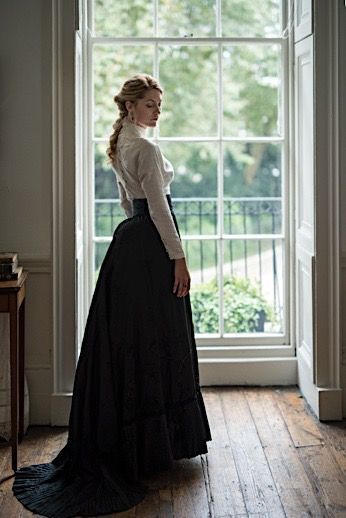
Allie Baldwin – a beautiful display of white space
There is something that I am paying attention to as I work on The Unforgettable Miss Baldwin, the first book in The Baldwin Family Series set in New York in the late 1800s. This is something that authors don’t pay that much attention to, unless they are self-published and do their own formatting or hire a formatter. What I”m talking about is “spacing”. Especially the “white space” around the words and paragraphs.
Whitespace is a fundamental building block of good design. It’s the first design aspect that any visual designer is taught. What is whitespace? Let me say that it’s not always white. This space may be a color or texture. For authors, white space is the space between blocks of text. Author reviews often mention that the book had lots of white space and they loved that, it gives the reader an enjoyable journey through the story. In this post I explain why whitespace matters. Design, a critically important element authors often overlook. Words on the page need balance, structure and white space. Maria Connor, Published Author and Author Assistant
IMPROVED LEGIBILITY:
The most obvious benefit of whitespace is that it increases legibility. You only need to compare the examples shown in Mark Boulton’s superb article on whitespace to see how a good use of whitespace can make an enormous difference to legibility.
HIGHER COMPRENSION:
Believe it or not whitespace between paragraphs and around blocks of text actually helps people better understand what they are reading. According to research in 2004, this kind of whitespace increases comprehension by almost 20%.

Before corrected with whitespace

After corrected with whitespace

Negative space fresh and open
CREATES THE RIGHT TONE:
Finally the use of whitespace can be a powerful way to communicate elegance, openness and freshness. Obviously this isn’t always the design look and feel you wish to communicate. However when it is, you can’t do better than having loads of whitespace.
For the visual arts, the phrase refers to negative space. In my work, I have found the old adage, “Less is more,” to be true. A phrase used by architect Ludwig Mies van der Rohe in 1947 as a precept for Minimalist design and architecture. The phrase has been used in other applications by the design community over the years. I use it in designing and painting all the time. It is part of my philosophy. The negative is as important as the positive.
Extra Whitespace Information: Did you know that your business card should have at least one whitespace the size of a quarter?And the backside should have a flat finish so the recipient can write who, where and when.
Not everyone thinks whitespace is important. As the volume of content on the web grows, how do you stand out from the noise? Website owners find whitespace to be a waste, they fill every open spot on the page. Websites have become a way to market and promote product with lots of noise. Website owners demand that every space say something. I never know where to look and cannot find anything on those busy websites.

Whitespace . . . Is this about two profiles in black silhouette or a goblet in white?

Starbucks clever use of good graphic design with lots of whitespace
Thanks to Paul Boag, click whitespace to see his blog and be sure to click Mark Boulton’s article on whitespace.
How about you? What do you think about whitespace?

The Write Space by Gail Ingis

Allie Baldwin – a beautiful display of white space
There is something that I am paying attention to as I work on The Unforgettable Miss Baldwin, the first book in The Baldwin Family Series set in New York in the late 1800s. This is something that authors don’t pay that much attention to, unless they are self-published and do their own formatting or hire a formatter. What I”m talking about is “spacing”. Especially the “white space” around the words and paragraphs.
Whitespace is a fundamental building block of good design. It’s the first design aspect that any visual designer is taught. What is whitespace? Let me say that it’s not always white. This space may be a color or texture. For authors, white space is the space between blocks of text. Author reviews often mention that the book had lots of white space and they loved that, it gives the reader an enjoyable journey through the story. In this post I explain why whitespace matters. Design, a critically important element authors often overlook. Words on the page need balance, structure and white space. Maria Connor, Published Author and Author Assistant
IMPROVED LEGIBILITY:
The most obvious benefit of whitespace is that it increases legibility. You only need to compare the examples shown in Mark Boulton’s superb article on whitespace to see how a good use of whitespace can make an enormous difference to legibility.
HIGHER COMPRENSION:
Believe it or not whitespace between paragraphs and around blocks of text actually helps people better understand what they are reading. According to research in 2004, this kind of whitespace increases comprehension by almost 20%.

Before corrected with whitespace

After corrected with whitespace

Negative space fresh and open
CREATES THE RIGHT TONE:
Finally the use of whitespace can be a powerful way to communicate elegance, openness and freshness. Obviously this isn’t always the design look and feel you wish to communicate. However when it is, you can’t do better than having loads of whitespace.
For the visual arts, the phrase refers to negative space. In my work, I have found the old adage, “Less is more,” to be true. A phrase used by architect Ludwig Mies van der Rohe in 1947 as a precept for Minimalist design and architecture. The phrase has been used in other applications by the design community over the years. I use it in designing and painting all the time. It is part of my philosophy. The negative is as important as the positive.
Extra Whitespace Information: Did you know that your business card should have at least one whitespace the size of a quarter?And the backside should have a flat finish so the recipient can write who, where and when.
Not everyone thinks whitespace is important. As the volume of content on the web grows, how do you stand out from the noise? Website owners find whitespace to be a waste, they fill every open spot on the page. Websites have become a way to market and promote product with lots of noise. Website owners demand that every space say something. I never know where to look and cannot find anything on those busy websites.

Whitespace . . . Is this about two profiles in black silhouette or a goblet in white?

Starbucks clever use of good graphic design with lots of whitespace
Thanks to Paul Boag, click whitespace to see his blog and be sure to click Mark Boulton’s article on whitespace.
How about you? What do you think about whitespace?

September 6, 2017
A suitcase, a red dress and a new pair of shoes

My brand new luggage! And check out my red dress and shoes!
If you traveled this summer, chances are you lugged a suitcase or two along. Think of how sleek and modern suitcases are today, with pockets and slots to fit everything you need.
My hear hubby Tom and I are taking two journeys soon, one on land, the other on the sea. We are off across the wide divide, with varied weather and lots of fun things to do. So of course, I had to buy new luggage. Oh goody shopping! I also bought a red dress and new shoes with lots of bling in both, but that’s another story. Tom and I prefer to travel light. Just how much room will be needed for two travelers for this type of trip? Our duffle bags do not cut it, so off to Costco I went and bought one large suitcase. I opened it up and there was a smaller one inside. Love it. They are just perfect for our needs. Travel is adventurous, but it’s also a lot of work to organize. Can you imagine what it was like in Victorian times with all those huge dresses, crinolines, corsets, shoes, stockings and toilet requisites? Fortunately, the crinoline was on its way out. A good excuse not to pack a hooped underskirt, or course an underskirt with no hoop was still necessary.

Allie Baldwin would have loved traveling in today’s modern era.
In my new series, The Baldwins’ of New York, my heroine, Allie, (The Unforgettable Miss Baldwin – Book 1) is involved with the women’s suffrage movement. Peter Harrison, the hero, owner of a security company, is hired by Allie’s father, Joseph Baldwin, to protect Allie. Much to her parents chagrin, she frequently puts herself in harm’s way. Allie and her sister Mia are determined to visit Fairfield, Connecticut (60 miles from New York City). Allie must travel there in order to write an important story (she writes for her father’s newspaper). With Peter along to protect them, nothing could go wrong, right? Wrong! You’ll have to stay tuned to find out what happens . . .
Allie, Mia and Peter traveled by train to Fairfield. The ladies were given an overnight compartment. In those days, the fashions were bulky. Consider how they had to travel and stay in Fairfield for an undetermined length of time. The Baldwin sisters had a massive travel trunk, a cumbersome box that even empty was too heavy for most. Thank goodness porters were always available at the train stations.

Painted steamer trunk by artist Mia Baldwin
Mia got all excited, she said, “Oh please Allie, let’s use the trunk that I painted.” (Mia is an artist).
“Of course Mia. It’s so lovely, everyone will comment on it.”
Do you think we can fit all of our clothes in that trunk?” asked Mia.
“Yes. Lay everything out that we want and then remove a third.”
“Oh, I wish it was easier to travel,” Mia said. “Imagine where we could go.”
Thank goodness for modern travel. I’ll stack my modern suitcase up against that trunk any day. Happy Travels.

Indigo Sky for the reader who enjoys historical romance! @AmazonKindle http://amzn.to/2nWqbcq Indigo Sky available on Amazon buy link: http://amzn.to/2j0LXLE
Author page: http://amzn.to/1K4GVQA
August 30, 2017
Where Heroes and Heroines Fall In Love: Why Setting Is So Important
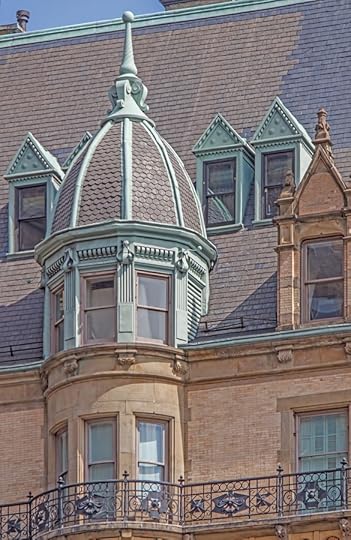
Dakota tower
My new historical romance series called “The Baldwins of Manhattan”, is set in New York City in the late 1800s. Joseph Baldwin, the patriarch is a newspaper publisher who owns six major newspapers in the United States (think William Randolf Hearst). Each book in the series follows the lives and loves of the five Baldwin children – Adam, Allie, Mia, and twins Emma and Ava who live with their equally wonderful parents, Joseph and Clara Baldwin in a unique apartment building called The Sandanko, in the then remote upper area of Manhattan. (It was not called the Upper West Side until the 20th century.) Well, to be honest, Adam, lives in Chicago and runs his father’s Chicago newspaper there (Adam’s book will be the final book in the series, and wait until you see what I have planned for Adam! His life will be turned upside down when he FINALLY finds true love. But back to the Sandanko. I situated this wonderful living facility, just across from Central Park. This building houses 60 families and will provide the backdrop for the Baldwin family series and more series to come! In fact, The Sandanko will be a prominent “character” in all of my upcoming books.
The inspiration for this building is based on The Dakota building. Now, this is where my 50+ years as an interior designer and educator come in. Setting is so important – it is literally and figuratively the foundation of the story. So with that in mind – I want to share with you some fascinating facts about The Dakota (my inspiration) for the setting of my WIP, THE UNFORGETTABLE MISS BALDWIN (book one in my Baldwin Family Series. The heroine is the eldest daughter in the Baldwin family, Allie. Allie writes for her father’s newspaper and is, shall we say, a might headstrong. But don’t worry, the hero Peter, in my book will be able to keep up with her. I can’t wait for you to read it. But in the mean time – here are some fascinating facts about The Dakota building:
Architect Henry J Hardenbergh designed The Dakota in1884. A local chap, he was born in New Brunswick, NJ. Schooled at Hasbrouck Institute in Jersey City, and apprenticed in New York from 1865-1870 under Detlef Lienau, architect of Lockwood-Mathews Mansion, Norwalk, CT. The Dakota apartments, a coop, is exclusive to the famous, movie stars, musicians and the wealthy.
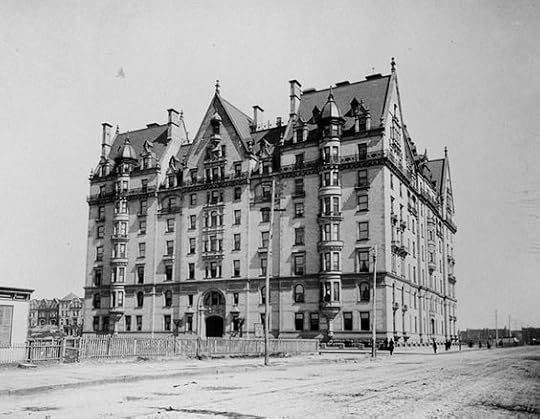
The Dakota built 1884, photo is c.1890 First building in this remote area
The Dakota got its name because the area was remote in relation to the rest of the Island of Manhattan, and more like the remote Dakota Territory, so far west and so far north, as mentioned in Christopher Gray’s book, New York Streetscapes.
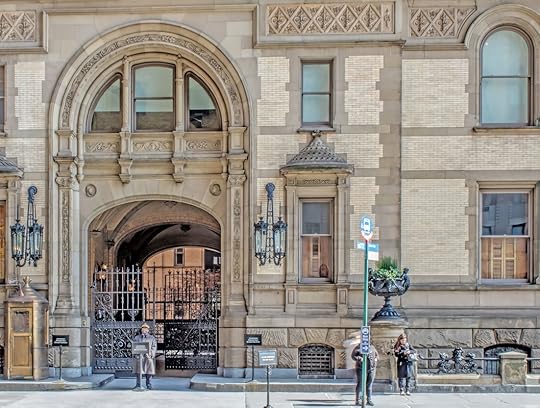
Entrance

The building’s high gables and deep roofs with a profusion of dormers, terracotta spandrels and panels, niches, balconies, and balustrades give it a North German Renaissance character, an echo of a Hanseatic town hall. Nevertheless, its layout and floor plan betray a strong influence of French architectural trends in housing design that had become known in New York in the 1870s. High above the 72nd Street entrance, the figure of a Dakota Indian keeps watch.

Dakota Indian figure
The Dakota is square, built around a central courtyard. The arched main entrance is a porte-cochère large enough for the horse-drawn carriages. The area is sheltered from the weather. The general layout of the apartments is in the French style of the period, with all major rooms not only connected to each other, in enfilade, in the traditional way, but also accessible from a hall or corridor, an arrangement that allows a natural migration for guests from one room to another, especially on festive occasions, yet gives service staff discreet separate circulation patterns that offer service access to the main rooms. The principal rooms, such as parlors or the master bedroom, face the street, while the dining room, kitchen, and other auxiliary rooms are oriented toward the courtyard. Apartments thus are aired from two sides, which was a relative novelty in Manhattan at the time. Some of the drawing rooms are 49 ft (15 m) long, and many of the ceilings are 14 ft (4.3 m) high; the floors are inlaid with mahogany, oak, and cherry.
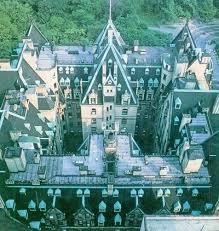
Courtyard
Originally, the Dakota had 65 apartments with four to 20 rooms, no two being alike. The apartments all look out onto an open courtyard as depicted here in this photo. These apartments are accessed by staircases and elevators placed in the four corners of the courtyard. Separate service stairs and elevators serving the kitchens are located in mid-block. Built to cater for the well-to-do, the Dakota featured many amenities and a modern infrastructure that was exceptional for the time. The building has a large dining hall; meals also could be sent up to the apartments by dumbwaiters. Electricity was generated by an in-house power plant and the building has central heating. Beside servant quarters, there was a playroom and a gymnasium under the roof. In later years, these spaces on the tenth floor were converted into apartments for economic reasons. The Dakota property also contained a garden, private croquet lawns, and a tennis court behind the building between 72nd and 73rd Streets.
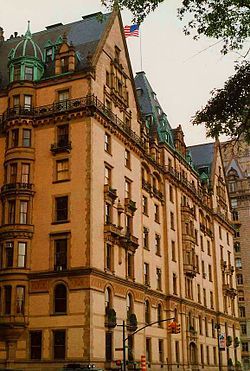
Dakota
All apartments were let before the building opened. For the high society of Manhattan, it became fashionable to live in the building, or at least to rent an apartment there as a secondary city residence, and the Dakota’s success prompted the construction of many other luxury apartment buildings in Manhattan.

Central Park at the foot of the Dakota
Wikipedia. Click this for more interesting facts like the famous who lived here, and John Lennon’s murder outside the building in 1980.
An entrance to the 72nd Street station of the New York City Subway‘s A B C trains is outside the building.
Dedicated as a National New York City Landmark in 1969, and in 1976 a National Historic Landmark.
My current book, INDIGO SKY (an historical romance inspired by The Lockwood-Mathews Mansion Museum) can be found on Amazon in three formats: print book, ebook, and audiobook.

Indigo Sky for the reader who enjoys historical romance! @AmazonKindle http://amzn.to/2nWqbcq Amazon buy link: http://amzn.to/2j0LXLE
Author page: http://amzn.to/1K4GVQA
August 23, 2017
HOW I MET MY HEROINE’S MOTHER
From Gail’s House Newsie News
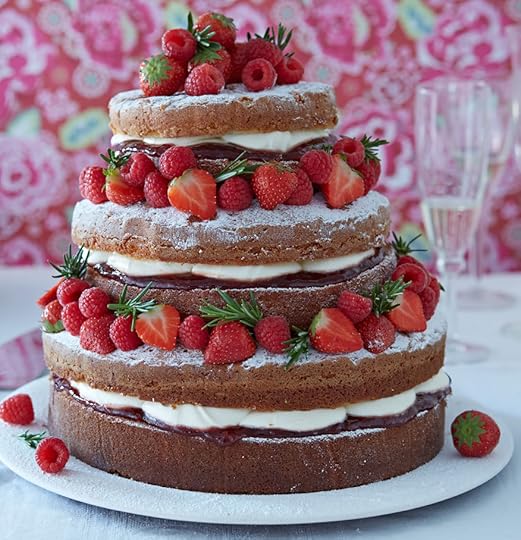
Rustic Wedding cake
Writing a story is like baking a cake. There are so many layers, each one more yummy than the next.
Interior design was also like that for me. For almost half my life, I helped to make peoples’ homes both beautiful and functional. Just like cakes are beautiful on the outside and oh, so good, on the inside. Someday, I’ll write that memoir, but right now I’m busy crafting the first book in my new, five-book series about a prominent family living in New York City in the late 1800s. And lucky me, I get to spend some time designing and decorating my heroine’s bedroom, and even luckier me, I get to spend some time with my heroine’s mother who is, of course, my exceptional client.
I prefer to be on a first name basis with all of my clients, and have never been refused. They seem to enjoy the familiarity.
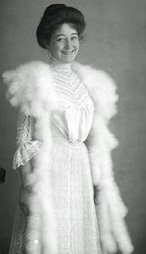
Mrs. Clara Baldwin
So, with a bright smile, I begin. “May I ask you, Mrs. Baldwin, if I may call you by your first name?”
Mrs. Baldwin replies, “Certainly. Please call me Clara. And may I call you Gail?”
“Of course,” I reply with a bright smile back.
“It is a pleasure to meet you Gail.”
“Clara, the pleasure is all mine. Thank you for this privilege.”
“I am so looking forward to working with you, Gail.”
“As am I,” I reply. “I have other questions to ask. Your answers will be the secret to our success. Will we be working on Allie’s room?”
“Yes.”
“How old is Allie?”
“She is twenty-five,” Clara reveals.
“Does she have a collection of sorts? Dolls perhaps?”
“Oh, my no,” Clara chuckles. “Allie is the last person who would have dolls in her room. No, my second daughter Mia adores dolls and has a very lovely collection. Allie, on the other hand, loves books. Her room is full of them. We have no idea where to put them all.
“She sounds like a very bright young woman.”
“She is absolutely brilliant,” Clara says, her eyes reflecting a mother’s pride and love.
“Who is her favorite author?” I inquire.

Window seat w/shelving
“Her favorite author is Charles Dickens. Allie loved his Bleak House. She thought it was a special book.”
“I read a Tale of Two Cities in school. It was heart wrenching.”
“Did you know Dickens’ pen name was Buz?
“No, I did not.
“Don’t you think it an odd name?”
“I do,” I reply. “But writers are very singular people are they not?”
“Indeed,” Clara says. “Allie is also a writer. She writes for my husband’s newspaper and she is probably the most singular person I have ever known.”
“Well then, we shall have to create some very singular shelving!”
“Shelving, where would you put that?”
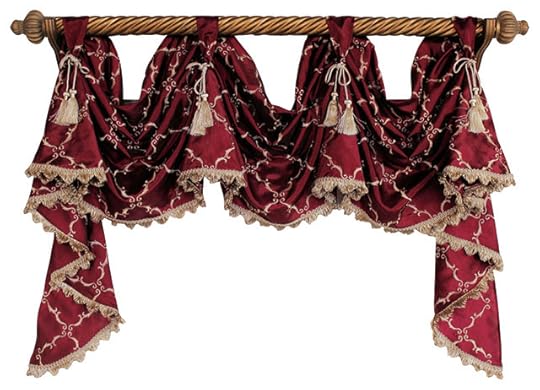
Victorian festoons & Jabots
I walk over to the beautiful bay window and say, “Right here on either side, with a lovely comfy cushioned seat beneath the window. Under the seat can be storage for more books if she desires, or anything else that she wants out of the way. Allie can tuck in and enjoy her books here. What do you think Clara?”
Clara clapped her hands. “Absolutely marvelous. I’ll share all of this with Allie. I’m sure she will love to know her books will be so beautifully displayed.”
“And what is that big cushion on the floor beside the bed?” I ask.
“Oh, that’s for Allie’s Great Dane, Captyn.” Clara arches one brow, but her eyes are twinkling, as though she is holding back a giggle. “It’s where he sleeps.”
“Well, I am certain that we can create a very singular bed for Captyn that will suit his size and stature.”

Great Dane Tuff Bolster nest
“That would be wonderful, since he usually ends up sleeping on Allie’s bed and then her bedding smells like dog the next day.”
We both burst out laughing.
“Can you tell me a little about the clothes she chooses?” I ask.
Clara tilts her head. “Nothing too fussy, why do you ask?”
“Her taste in clothes tells me a great deal about what she likes to live with.”
“Ah,” Clara nods. “Well, she often expresses how ridiculous corsets are and refuses to wear one. She is contemporary, if that has a meaning to you.

Simply divine
“Why yes, of course. I take it she prefers the new style with no crinoline, simple lines.”
“She certainly does.”
“I’ll put together three floor plans, with wallpaper and fabric choices. Then we can pick one or a combination. The plans will offer Allie’s singular pick within her taste.
“That sounds wonderful Gail, I can’t wait to see your suggestions.”
“Clara, we have run out of time, but I will come back soon with the plans, if that’s suitable.”
The choices that Allie makes, with her mother’s approval, of course, will be revealed in, The Unforgettable Miss Baldwin.

Indigo Sky for the reader who enjoys historical romance! @AmazonKindle http://amzn.to/2nWqbcq Indigo Sky available on Amazon buy link: http://amzn.to/2j0LXLE
Author page: http://amzn.to/1K4GVQA



